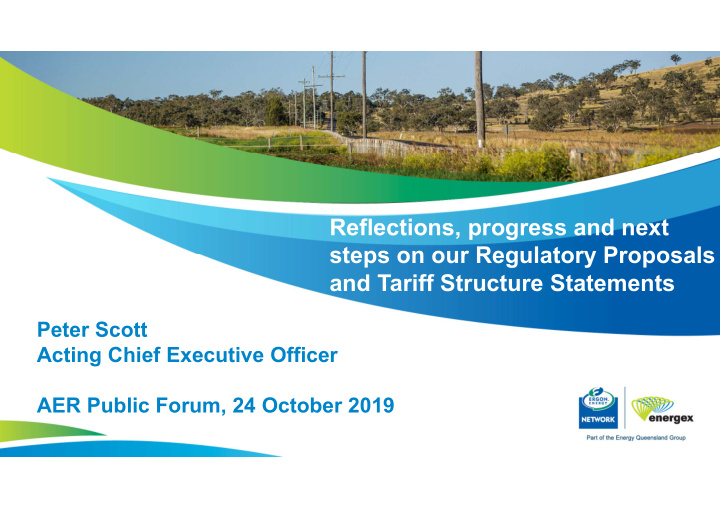



Reflections, progress and next steps on our Regulatory Proposals and Tariff Structure Statements Peter Scott Acting Chief Executive Officer AER Public Forum, 24 October 2019
Reflections • Customer feedback was key to shaping our Regulatory Proposals and Tariff Structure Statements • Affordability was a central concern • Our submissions to date have aimed to improve affordability, with commitments to reduce network costs • The Draft Decisions handed down from the AER seek further decreases in expenditure and revenue • Our challenge is how to balance our customer commitments of affordability with safety, security and sustainability for 2020 and beyond 2
Our Customer Commitments Reflected in Our Regulatory Proposals • Our proposals made commitments in four key areas • Reflecting what we heard was important – in our engagement with you, and – in our customer research • The draft decisions challenge our ability to deliver these 3
AER Draft Decisions | Revenue Drivers 4
Draft Decision Outcomes Energex: Ergon Energy: Topic RP DD Variance $ Variance % Topic RP DD Variance $ Variance % Revenue (smoothed) Revenue (smoothed) 6,516 5,787 -729 -11.2% 6,541 5,840 -701 -10.7% (Nominal $M) (Nominal $M) P0 (initial real revenue P0 (initial real revenue 10.25% 20.32% 10% +98.2% 9.44% 16.77% 7.33% +77.6 decrease in 2020/21) decrease in 2020/21) Operating expenditure Operating expenditure 1,805 1,947 +142 +7.8% 1,835 1,964 129 7% (opex) (Real $M) (opex) (Real $M) Net Capital expenditure Net Capital expenditure 2,020 1,793 -227 -11.2% 2,724 2,151 -573 -21.0% (capex) (Real $M) (capex) (Real $M) 5
Key Capex considerations Closing the evidence gap 01 Focusing on addressing the evidence and justification gaps identified by the AER to support our safety, legislation and compliance driven Capex Program. Delivering Safety 02 Developing a fit for purpose Capex Program that ensures the safety of the network, staff, customers and community and the legislative compliance obligations of the business. 6
Reflections and new factors Demand Forecast CTG/CTS Poles Energex consideration Ergon consideration Ergon consideration Demand Forecast for Energex has Ergon identified a significant number of Ergon Energy Network has reviewed increased since the Regulatory additional Clearance to Ground / its Pole Inspection and Assessment Proposal was submitted in January Clearance to Structure defects in Methodology due to increases in pole 2019. February 2019. failure rates. Ergon Energy Network has also It is now anticipated that energy This change has identified a significant received Electrical Safety Office notices delivered annual average growth of number of poles that need remediation associated with these defects requiring around 0.4% over the 2020-2029 action. immediate remediation action. period. Ergon Energy Network did not forecast Ergon Energy Network did not forecast for these defects in its Regulatory Although there is an anticipated growth, for these pole replacements in its Proposal in January 2019. Energex is considering what action Regulatory Proposal in January 2019. needs to be taken in the next regulatory Ergon Energy Network has also period. started remediation action deferring currently planned work to fund the current remediation work. 7
AER Draft Decision | Opex Next Steps Key Considerations Sustainability Affordability 01 02 A reduced WACC and changes in the regulatory We remain committed to improving tax approach have resulted in revenue reduction affordability and will now get there easily, but that exceeds the reduction we included via we must balance that against sustainability of proposed Opex efficiencies. the businesses Severe weather events Transparency of benefits 03 04 Increasing frequency and severity of storm, We are assessing the quantified efficiencies in cyclone, flooding and fire events across the our businesses cases (e.g. for ICT and for network is a necessary consideration. These property) to account for these in the revised events are increasingly becoming a business- regulatory proposals and ensure they are as-usual cost rather than one-off costs. achievable and sustainable. 8
Efficiency Incentive schemes • In their Draft Decisions, the AER allowed us the flexibility to reassess our approach to the efficiency incentive schemes in our RRP: “If, in its revised proposals, Energex/Ergon Energy elects to claim its EBSS and CESS rewards, then we will adjust the total revenue for the next regulatory control period in our final decision by adding the EBSS and/or CESS rewards it has accrued in the current period” • Energex and Ergon Energy elected to forgo efficiency incentive scheme payments subject to the AER’s acceptance of their regulatory proposals • As the AER’s DD did not accept the regulatory proposals, Energex and Ergon Energy are reconsidering the inclusion of these payments in their revised regulatory proposal submissions 9
AER Draft Decision | Network Tariffs Next Steps Key Considerations Affordability Simplicity 01 02 Downward pressure on prices. In all of our Developing network tariffs that can be considerations we have listened to customers – with understood by customers to ensure they can the focus on affordability. We have also focused on respond to the price signal. We are also ensuring that customer impact is managed through intending to work collaboratively with retailers the development of transitional cost reflective to develop education material to inform structures, setting rates and providing tariff options. customers about our tariff suite. Cost-reflectivity Choice 03 04 Equitable charging for the use of the network by unwinding cross-subsidies. Providing opportunities to control and save through changes in behaviour by consuming electricity outside the peak period. 10
AER Draft Decisions | Next Steps Our continued engagement • We have been actively engaged and working with the AER and will continue to do so as we progress our RRP • We will continue to engage with our stakeholders and customers on the issues critical to them • We will discuss TSS related customer impact analysis and proposed rates with stakeholders and customers at future working groups and other forums 11
Recommend
More recommend